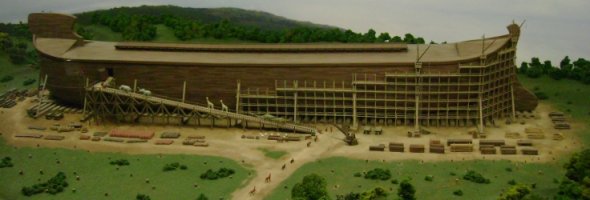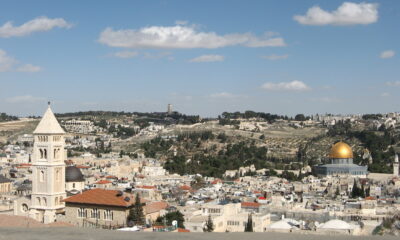Creation Corner
Noah’s Ark – introduction

Noah’s Ark is the biggest stumbling block against a literal belief in the Bible. But the story is still real, and relevant to today.
New interest in Noah’s Ark
Two recent events have people paying attention to the story of the Global Flood and Noah’s Ark. Specifically:
- A State tourism development board has approved start-up tax incentives for a new theme park in Kentucky. The centerpiece of the park will be a full-sized shipwright’s concept of Noah’s Ark.
- A Japanese industrialist has designed a new kind of “lifeboat for the land,” that people can use to survive a tsunami. He based his design on Noah’s Ark.
Interest in Noah’s Ark is not new. The worldwide recession (depression?) caused many visitors to flock to several Noah’s Ark concept models that already stand in various cities around the world.
Some of these Ark “replicas” are full-sized, or as near to full-sized as their designers can guess. Others are smaller, from a smaller scale. One actually floats.
But people today find the story hard to believe, because they cannot imagine it. A child will accept the Flood story without question. An adult will not. So he asks perfectly good questions, and might even think that no one can answer them. But—though he might not want to admit it—his questions do have answers.
Questions about the Global Flood
Where did the Flood waters come from, and where did they go?
The Flood waters began as a vast ocean in a sealed room under the earth’s crust. Back then, the crust was ten miles thick. On the date that the Bible gives (17 Vul AM 1656), a hairline crack appeared in the crust. The tremendous pressure beneath it widened that crack very quickly, until it went all the way around the world.
This water was supercritical (so hot and so compressed that liquid and vapor literally dissolved each other). When the crack let this water out of its prison, it shot up, cooled down, and fell back as rain and hail. So the “fountains of the great deep” were the oceans of water under the crust, the “break-out” was the crack in the crust, and the “windows of heaven opening” and “forty days and forty nights of rain” were the waters shooting high into the sky and falling back. (And they didn’t all fall back! About one percent of the earth’s total weight sailed on to form comets, asteroids and meteoroids.)
This water did not “go” anywhere. It’s still here, except for the part that escaped into outer space. The Atlantic, Pacific, Indian, and Arctic Oceans hold it now. The crack is still here, too. We call it the Mid-Oceanic Ridge system.
How could Noah’s Ark stay afloat in such incredibly rough seas?
[ezadsense midpost]
Simple: Noah’s Ark had the best proportions of any ship built before or since. Its proportions are 30:5:3. That 5:3 ratio is close to golden. That is, the ratio of height to beam is almost the same as the ratio of the beam to the sum of beam plus height. Architects know that a door or window cut to that proportion is most pleasing to the eye. Naval architects know that ratio strikes the best balance between stability and “sea-kindliness.” Actual sea trials show that a vessel with those proportions would not break, capsize, or give too rough a ride to its crew and cargo.
Why wouldn’t the hot waters have parboiled Noah’s Ark and everyone and everything on board?
Remember two things. First, the water was at the critical temperature or slightly hotter—before the crack in the crust let it out. Once it got out, it spread out—and cooled down very fast.
Think of your refrigerator. A home refrigerator uses a gas called freon to cool things down. First, a compressor will put liquid freon under pressure. Then the liquid passes into a large chamber, that will immediately take the pressure off. When that happens, the freon will expand and become a gas. To do that, it must take heat from its surroundings. Turning anything from liquid to gas takes energy. This cold gas will pass to a condenser, become liquid again, and flow back to the compressor.
The Flood waters simply spread out and changed from supercritical fluid to water vapor in little more than an instant. The mass of water that flowed over the earth cooled down to a temperature quite comfortable for a wooden ship like Noah’s Ark. The water that shot up into the sky either fell back as rain, or froze and fell back as hail. So Noah’s Ark was in no danger of “parboiling.”
Second: the water would not have been as hot as lava from a volcano. Before the Flood, the earth had no volcanoes. The tremendous heat locked up in the earth below its crust came from two causes:
- The crust broke up into plates that crashed into the floor of the old water chamber, or into one another.
- With much of the earth’s mass falling in on itself, all that energy had to go somewhere. If something falls onto something else and can’t move anymore, everything gets hot. That’s the First Law of Thermodynamics.
This didn’t threaten Noah’s Ark because the heat release came after the Flood began, not before.
Questions about Noah’s Ark
How did only eight people take care of all those animals?
Noah built the Ark to make caring for the animals easy. True, most zoos today have many more employees for the number of animals in their care than Noah had available on Noah’s Ark. But that does not mean that the zoo builders were the greatest architects that ever practices. Noah already had 480 years of life under his belt before he started to build Noah’s Ark. He would have known to build everything “ship-shape.” Tim Lovett (Noah’s Ark: Thinking Outside the Box) drew these concepts for the cages of various sizes that Noah’s Ark might have used.
What about sea creatures?
What about them? Noah’s Ark needed room only for the land animals. The sea creatures could take care of themselves, and did.
What about freshwater fish and so on?
Give those animals some credit for being adaptable! They wouldn’t have had to adapt to the very salty oceans of today.
What about dinosaurs? Was the Ark really big enough to hold even one of them?
The largest dinosaurs had hundreds of years to grow that large. Noah’s Ark was large enough to carry young and young-adult dinosaurs.
How could Noah’s Ark possibly carry two of every species of land animal and bird that we know today?
It didn’t have to. Creation science does not say that God created every modern species in the six-day Creation Week. The Bible mentioned kinds, not “species” as we understand the word. The created kinds are the families of modern biology. (Even if the kinds are the genera of today, Noah’s Ark would have big enough to carry two of every kind, with room to spare.)
How did kangaroos, koalas, and other species from Australia or New Zealand get aboard Noah’s Ark?
They walked, and didn’t have to swim. Before the Flood began, all the continents were one continent. The crack in the world broke the Americas off from the modern Eastern Hemisphere—and shoved them violently to the west. That, incidentally, is why we have the Rocky/Sierra Madre/Andes mountain chain, and the Appalachian mountain chain further east. (And haven’t you noticed? Most mountain chains run north-to-south, not east-to-west. Ever wondered why? A mountain chain is a wrinkle in the crust, and wrinkles happen when a moving sheet stops moving and folds up.)
You mean they walked all that distance to that one spot?
Sure. They had plenty of time—120 years. And Noah’s Ark was probably at the travel centroid of the world, the one place to which the sum of all travel distances would be the shortest. That travel centroid persists today—at Jerusalem.
Any other questions?
Featured image: a model of Noah’s Ark under construction. Photo: Creation Museum/Answers in Genesis, taken and used by permission.
[ezadsense leadout]
Terry A. Hurlbut has been a student of politics, philosophy, and science for more than 35 years. He is a graduate of Yale College and has served as a physician-level laboratory administrator in a 250-bed community hospital. He also is a serious student of the Bible, is conversant in its two primary original languages, and has followed the creation-science movement closely since 1993.
-

 Civilization2 days ago
Civilization2 days agoDC Pipe Bomb Arrest Raises Questions About Christopher’s Wray’s FBI
-

 Guest Columns4 days ago
Guest Columns4 days agoCongressional Leaders See Far Higher Stock Returns Than Peers
-

 Civilization3 days ago
Civilization3 days agoThe Legal Logic Behind U.S. Operations Against Narco-Terrorist Networks
-

 Civilization4 days ago
Civilization4 days agoHow Trump Changed America
-

 Executive3 days ago
Executive3 days agoNewsom’s ‘National Model’ for Homeless Wracked by Fraud
-

 Executive2 days ago
Executive2 days agoWhen You’re in a Hole, Stop Digging
-

 Education2 days ago
Education2 days agoWaste of the Day: Taxpayers Subsidize Football Coach Severance
-

 Civilization1 day ago
Civilization1 day agoPence Calls on Trump To Fire RFK Jr Over Abortion Drug















Given that Noah was 600 years old at the time, was he not tired after building a boat big enough for these animals?
Was he really 600?
Why did God want to kill all but a few of the land animals, but was happy for all the fish to survive?
Did any fishermen survive? If not why not?
Did all the birds survive?
Why do you think that an old story which flouts all scientific understanding, common sense, and most Christian’s opinions is realistic?
Was Noah really 600 years old? Yes. Radiation, from the formation of radioactive elements in the earth’s crust (from the magnitude-10-to-12 earthquakes attendant on the Flood) and the “cluster decay” of those elements into carbon-14 and other such poisons, diminished the life span of man by ninety percent, and in a hurry.
No fishermen survived, because the seas were too violent for that. Noah’s Ark was the only ship that could survive.
After the Flood, Noah lived on for another 350 years.
The only birds that survived were those aboard the Ark.
And the only responsibility that I have, toward “Christians” who don’t believe their own Bible, is to educate them to show that the account is not only realistic but bank-on-it trustworthy.
I don’t follow the logic that earthquakes (no geological evidence of mag 10 or 12 earthquakes 7,000 years ago) can somehow form elements. Carbon-14 has a half-life of 7,300 years yet exists in only minuscule quantities today. From what you have said it should therefore still be abundant, poisoning things. Levels of C14 have actually been shown to be roughly constant for the last 12,000 years from analysis of many thousands of overlapping tree rings.
The only birds that survived were those aboard the Ark.
But why? What stopped birds landing on the ark or, for example, seaguls and ducks landing on the water. Afterall, the seaguls would still have plenty of fish to eat.
This is a repost (slightly edited) of my comments on the partial post Terry made on his main pages…..
Terry claims:
Noah’s Ark is the biggest stumbling block against a literal belief in the Bible.
Geno answers:
Not really. To me, it’s my ability to go out in my back yard at night and directly observe the galaxy Andromeda (distance 2.4 million light years) with my unaided eyes. In a 6000 year old universe, I shouldn’t be able to see anything beyond 6000 light years. Of course, on a cosmological scale, Andromeda is right next door…. other galaxies range out to 12,000,000,000 light years.
…
#####
Terry claims:
Some of these Ark “replicas” are full-sized, or as near to full-sized as their designers can guess. Others are smaller, from a smaller scale. One actually floats.
Geno points out:
The one that “actually floats” is floating all right… on a barge, not on its own. (Look carefully at the picture and you can see the barge.) Take the barge away, Terry, and see what happens to it. Better yet…. tow it out to the North Sea and let it ride out just one good winter storm.
#####
Terry says:
But people today find the story hard to believe, because they cannot imagine it.
Geno answers:
It’s not hard to believe because I “cannot imagine it” but because it fails critical analysis using basic physics of which any competent university freshman is capable.
#####
Terry claims:
About one percent of the earth’s total weight sailed on to form comets, asteroids and meteoroids.
Geno points out:
And about 20% of the comets is carbon monoxide. The release of that much CO into the atmosphere will kill all life in minutes. Do you have a way to separate the CO from the water so the heavier CO (atomic mass 26) will escape while the lighter water (atomic mass 18) will be left behind? No? Didn’t think so.
#####
Terry claims:
Actual sea trials show that a vessel with those proportions would not break, capsize, or give too rough a ride to its crew and cargo.
Geno points out:
There have been no “actual sea trials” with a 450 foot long wood ship in the open ocean. The problem isn’t stability or bouyancy, it’s hull flexure. Simply stated, the bending and twisting of the hull in rough seas will cause leaks to open up. The longest wood ships were only a little over 300 feet and they required steel reinforcing bands and constant pumping to remain afloat.
#####
Terry claims:
Think of your refrigerator. A home refrigerator uses a gas called freon to cool things down.
Geno points out:
Right…. freon has a boiling temperature typically around -40C (which is, coincidentally, -40F). Therefore, the freon can remove a lot of heat as it boils. Supercritical water, on the other hand, has a temperature of about 375C (over 700F). Terry (and Walt Brown) would have you believe this 700F steam will cool its surroundings. Not by a long shot. In fact, the steam will actually heat the surroundings until it cools to below the local temperature. Further, a lot of it will condense back to liquid water releasing a LOT of heat energy.
Think about it…. if we could cool the surroundings by simply releasing superheated (700+ F) steam to the air, why would we even bother with freon?
Go ahead, Terry, show my understanding of “basic refrigeration” is wrong.
#####
Terry claims:
The water that shot up into the sky either fell back as rain, or froze and fell back as hail.
Geno points out:
The Stefan-Boltzmann law dictates the maximum amount of energy that can be transmitted to space. It’s only a small fraction of what would be released as all that steam condenses to water vapor. Even Dr. Brown knows that much energy cannot be radiated to space in the limited time available.
Noah’s goose would be cooked…. both figuratively and literally.See More
You mentioned the Stefan-Boltzmann Law. You have got to be kidding. The Stefan-Boltzmann Law concerns black-body radiation. It has nothing whatever to do with the kinetic energy of megamegatons of supercritical water released all at once, and subject to water hammer.
If you’re going to drop names to try to gull people with your hoity-toity presentations, at least try to remember that no one disabled the search engines.
Terry said:
You mentioned the Stefan-Boltzmann Law. You have got to be kidding. The Stefan-Boltzmann Law concerns black-body radiation. It has nothing whatever to do with the kinetic energy of megamegatons of supercritical water released all at once, and subject to water hammer.
Geno answers:
WOW Terry ! ! ! ! I thought you said you have an engineering degree.
Black-body radiation has nothing to do with the color of the object and everything to do with its ability to radiate energy to space. In other words, the Stefan-Boltzmann law describes the temperature necessary to transfer heat energy to space over a period of time.
The Wikipedia article on the Stefan-Boltzman law shows Stefan used his law to estimate the temperature of the Sun within 2% and the law can be used to estimate the temperature of the Earth within 3%. While Earth is not a perfect blackbody the Stefan-Boltzman law provides an excellent approximation of the temperature necessary to radiate a given amount of heat to space over a specific time period.
Oh yeah…. we could always talk about the kinetic energy released by just 5% of the mass Brown says was launched to space falling back to Earth. How many steam processes do you know of that are over 95% efficient, Terry?
Terry claims:
If you’re going to drop names to try to gull people with your hoity-toity presentations, at least try to remember that no one disabled the search engines.
Geno answers:
I fully recommend they use their search engines. I also suggest they read past the first sentence or two. They should also check out how much “refrigeration” will be provided by the release of an amount of 700+F steam into the atmosphere equivalent to the water content of half Earth’s modern oceans.
I submit one of us is trying to “gull people”…. and it is NOT me.
This is a repost of my comments to Terry from his “Examiner” blog:
Terry claims:
Questions about Noah’s ArkHow did only eight people take care of all those animals?
Geno points out:
Noah, his wife, and children would have only 2 sets of alleles. Their (3) wives would have another 3 sets. That makes 5 sets of alleles in the entire human population. Modern humans have hundreds. This would require evolution on a scale not imagined by any mainstream scientist.
…
#####
Terry claims:
Noah already had 480 years of life under his belt before he started to build Noah’s Ark.
Geno points out:
The ancients ate stone-ground grain. This includes a lot of abrasive grit that would wear their teeth to nothing in much less than 480 years. Once the roots of their teeth are exposed, abscess and infection would (probably) kill pretty quickly.
#####
Terry claims:
Creation science does not say that God created every modern species in the six-day Creation Week. The Bible mentioned kinds, not “species” as we understand the word. The created kinds are the families of modern biology.
Geno answers:
1) “Creation science” is an oxymoron.
2) If Noah carried one of each family (or genera), evolution of new species would have to take place hundreds (if not thousands) of times faster than mainstream science proposes.
3) “Kind” is certainly more like the modern term “species.” Leviticus 11 lists 3 kinds of owl; 2 kinds of hawk; 2 kinds of eagle; even 2 kinds of locust.
Terry, while I appreciate your attempts to answer these questions, there are still many, many problems with what you’ve proposed.
If the amount of water necessary to cover the entire world were released as steam, you would poach all life off this earth as we know it. Not only that, but the force this steam would have to be released with, in order for it to achieve escape velocity like you’ve said, is beyond reasonable. You claim it cools, but it has to get into the atmosphere in order to condense and fall back as rain, so it cannot cool down immediately. Furthermore, with that much additional water vapor in the atmosphere, it would likely begin to condense on the inside of a person’s lungs and drown them.
What you’ve said about fish, both salt water and fresh water, violates everything we’ve come to know through marine biology about the concept of salinity. Fish have to adapt to the specific salinity of their environment, this change is not immediate, and taking next to any fresh water fish or salt water fish and putting that fresh water fish in salt water or a salt water fish in fresh water will kill it. There are exceptions, but they are very, very few. What you’ve proposed would have killed off well over 99% of all aquatic life.
You try to claim that it is not two of each species, but two from each family of animal. Turtles, alone, belong to 14 different families. Spiders have 109 different families. Frogs have 31 different families. That’s just frogs, turtles and spiders (by no means an exhaustive list of “kinds”), and you already have to carry and care for 308 different animals. While this makes the problem much more reasonable to solve, it still doesn’t solve it as you quickly run into more animals than eight people could ever possibly care for without sophisticated automation (next you’ll be claiming Noah built wooden robots to help care for the animals). Also, many of these animals have parasites, which are their own “kind” of animal onto themselves and two of each would need to be preserved, to say nothing of the massive quantities of parasites and diseases Noah and his family would have provide refuge for in their own bodies.
A Koala sleeps for 16-18 hours a day, has no real defenses of any sort, and only eats eucalyptus. Even allowing for one massive continent so that the Koala doesn’t have to swim thousands of miles, you’d still have to get them back to Australia after the flood is over, and then the Koala would still have to swim thousands of miles. The same is true of the sloth, and a dozen other animals. Not only is what you’ve proposed completely impossible, it is entirely dissonant with what we’ve come to learn and understand about biogeography through the theory of evolution.
As for Noah knowing more about naval architecture than anyone, the ark had no rudder, it had no sails, it had no compass, it had no pumps, it had no charts, no lead-lines, no anchors, no log, no light, no ventilation, no tanks to store fresh water, none of the things that we’ve come to accept as necessary parts to a boat. I don’t know if you’ve been in a wooden boat, but they take on water. A boat that size would need more than eight people just working buckets in order to keep the thing from taking on too much water and going under.
You still haven’t mentioned how Noah provided food and fresh water for all of these animals, nor how eight people (each stricken with around 15 parasites a person) cleaned up after them. A zoo with just two elephants will typically require more than just eight people (eight healthy people) to care for these elephants alone. A singular elephant eats an absurd amount and poops an absurd amount. Not only would Noah have to provide more food than the ark could hold, eight people could not clean up after those animals.
What is there to eat when the ark lands? Noah doesn’t save any plant life, and given the conditions you’ve described, no plant life would have been able to survive. Noah and the animals would have survived the flood, only to arrive at a barren mud flat, entirely devoid of vegetation. The herbivores would starve, and if the carnivores ate the herbivores what would be the point of saving all those animals to begin with?
Having a breeding population of two would cause a genetic bottleneck so bad that the species would likely not be capable of surviving. Having a breeding population of eight would cause the exact same thing for people (this is why the concept of Adam and Eve is also nonsensical).
Not only is there no evidence for anything you’ve said Terry, but everything you’ve said flies in the face of logic and reason. I’m not even going to touch the dinosaur thing since you’re just making stuff up.
The story doesn’t even make much sense outside of all of the impossible gibberish. The first thing Noah does after getting off the ark is to get drunk on wine and pass out naked. God really felt this was the best humanity had to offer?
I find Noah’s ark is a better story to take as a metaphor for how a singular just man can save an unjust world rather than a literal account of how God decided to purge the world of 99% of all life on it, saving that one percent with the help of a wino and his family.
For further reading, I would recommend Mark Twain’s Letters from the Earth, as he pretty much destroyed your entire argument over 100 years ago. Read it here.
Great reporting Terry. I enjoy seeing the comments that are coming here ;) See you on Examiner.com
[…] Noah's Ark – introduction – Conservative News and Views What about dinosaurs? Was the Ark really big enough to hold even one of them? The largest dinosaurs had hundreds of years to grow that large Noah's Ark was large enough to carry young and young-adult dinosaurs. […]
The largest dinosaurs got that big because they had 900 years or so to get that big. Reptiles don’t stop growing, the way mammals do. They just keep growing, and growing, until they die. And back then, everything lived longer. That is, until the natural nuclear reactor that the whole earth’s crust became, dumped a lot of carbon-14 into the atmosphere. That’s why we don’t live so long anymore.